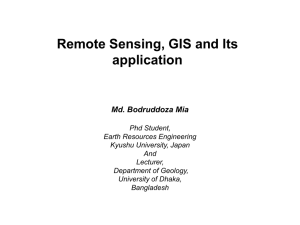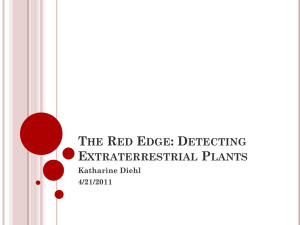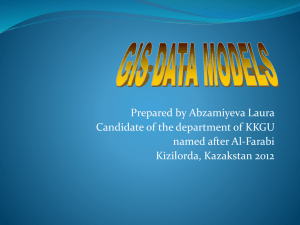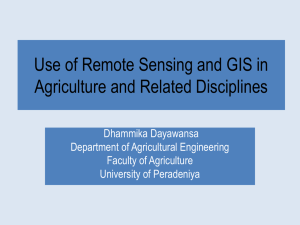Chapter 1 Concepts and foundations of Remote Sensing
advertisement
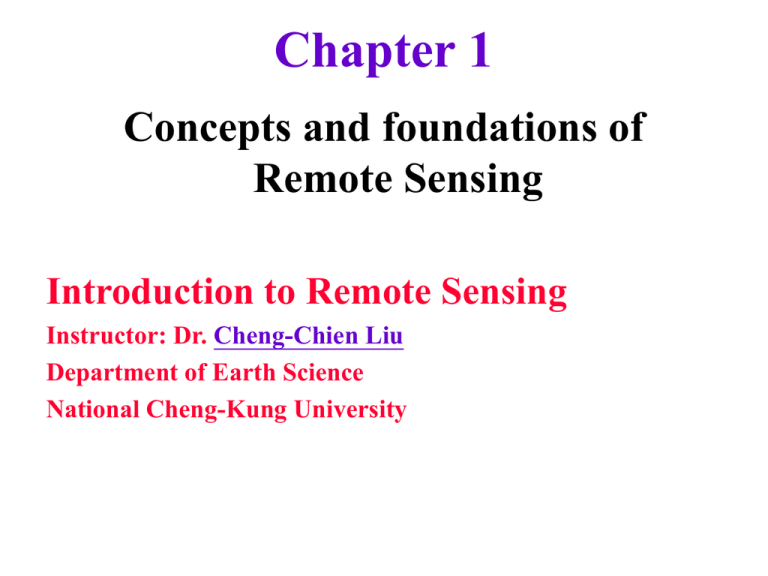
Chapter 1 Concepts and foundations of Remote Sensing Introduction to Remote Sensing Instructor: Dr. Cheng-Chien Liu Department of Earth Science National Cheng-Kung University 1.1 Introduction General definition of Remote Sensing: The Science and art of obtaining information about an object, area, or phenomenon through the analysis of data acquired by a device that is not in contact with the object, area, or phenomenon under investigation. • e.g. reading process word eyes brain meaning data sensor processing information 1.1 Introduction (cont.) Collected data can be of many forms: • variations in force distribution e.g. gravity meter • acoustic wave distribution e.g. sonar • electromagnetic energy distribution e.g. eyes • our focus: electromagnetic energy distribution 1.1 Introduction (cont.) Fig. 1.1 Generalized processes and elements involved in electromagnetic remote sensing of earth resources. • data acquisition: a-f (§1.2 - §1.5) • data analysis: g-i (§1.6 - §1.10) 1.2 Energy sources and radiation principles Fig. 1.3 electromagnetic spectrum memorize • Wave theory: c = nl c : speed of light (3x108 m/s) n : frequency (cycle per second, Hz) l : wavelength (m) • unit: micrometer mm = 10-6 m 1.2 Energy sources and radiation principles (cont.) Fig. 1.3 (cont.) • Spectrum : UV (ultraviolet) Vis (visible) narrow range, strongest, most sensitive to human eyes blue: 0.4~0.5mm green: 0.5~0.6mm red: 0.6~0.7mm IR (infrared) near-IR: 0.7~1.3 mm mid-IP: 1.3~3.0 mm thermal-IR: 3.0 mm~1mm heat sensation microwave: 1mm~1m 1.2 Energy sources and radiation principles (cont.) Fig. 1.3 (cont.) • Particle theory: Q = hn Q: quantum energy (Joule) h: Planck's constant (6.626x10-34 J sec) n: frequency • Q = hn = hc/l 1/l implication in remote sensing:lQ viewing areaenough area 1.2 Energy sources and radiation principles (cont.) Stefan-Boltzmann law: • M = sT4 M: total radiant exitance from the surface of a material (watts m-2) s: Stefan-Boltzmann constant (5.6697x10-8 W m-2K-4) T: absolute temperature (K) of the emitting material • blackbody: a hypothetical, ideal radiator totally absorbs and reemits all incident energy 1.2 Energy sources and radiation principles (cont.) Fig 1.4: Spectral distribution of energy radiated from blackbodies of various temperatures • Area total radiant exitance M T M (graphical illustration of S-B law) • Wien's displacement law: lm=A/T 1/T lm : dominant wavelength, wavelength of maximum spectral radiant (mm) A: 2898 (K) T: absolute temperature (K) of the emitting material e.g. heating iron: dull red orange yellow white 1.2 Energy sources and radiation principles (cont.) Fig 1.4 (cont.) • Sun: T6000K lm0.5mm (visible light) • incandescent lamp: T 3000K lm 1mm "outdoor" file used indoors "yellowish“ need high blue energy flash compensate • Earth: T 300K lm 9.7mm thermal energy radiometer l<3mm: reflected energy predominates l>3mm: emitted energy prevails • Passive Active 1.3 Energy interaction in the atmosphere Path length • space photography: 2 atmospheric thickness • airborne thermal sensor: very thin path length • sensor-by sensor 1.3 Energy interaction in the atmosphere (cont.) Scattering • molecular scale: d << l Rayleigh scatter Rayleigh scatter effect 1/l4 "blue sky" and "golden sunset" Rayleigh "haze" imagery filter (Chapter 2) • wavelength scale: d l Mie scatter influence longer wavelength dominated in slightly overcast sky • large scale: d >> l e.g. water drop nonselective scatter f(l) that's why fog and clod appear white why dark clouds black? 1.3 Energy interaction in the atmosphere (cont.) absorption • absorbers in the atmosphere: water vapor, carbon dioxide, ozone Fig 1.5: Spectral characteristics of (a) energy sources (b) atmospheric effect (c) sensing systems atmospheric windows 1.3 Energy interaction in the atmosphere (cont.) important considerations • sensor: spectral sensitivity and availability • windows: in the spectral range sense • source: magnitude, spectral composition 1.4 Energy interactions with earth surface features Fig 1.6: basic interactions between incident electromagnetic energy and an earth surface feature • EI(l) = ER(l) + EA(l) + ET(l) incident = reflected + absorbed + transmitted • ER = ER(feature, l) distinguish features R.S. in visible portion: ER(l) color most R.S. reflected energy predominated ER important! 1.4 Energy interactions with earth surface features (cont.) Fig. 1.7: Specular versus diffuse reflectance • specular diffuse (Lambertian) • surface roughness incident wavelength: lI • if lI << surface height variations diffuse for R.S. measure diffuse reflectance • spectral reflectance E R (l ) l E I (l ) 1.4 Energy interactions with earth surface features (cont.) Fig 1.8: Spectral reflectance curve (SRC) • object type ribbon (envelope) rather than a single line • characteristics of SRC choose wavelength • characteristics of SRC choose sensor near-IR photograph does a good job (Fig 1.9) • Many R.S. data analysis mapping spectrally separable understand the spectral characteristics 1.4 Energy interactions with earth surface features (cont.) Fig 1.10: Typical SRC for vegetation, soil and water • average curves • vegetation: pigment chlorophyll two valleys (0.45mm: blue; o.67mm: red) green if yellow leaves (red) green + red from 0.7 mm to 1.3 mm minimum absorption (< 5%) strong reflectance = f(internal structure of leaves) discriminate species and detect vegetation stress l > 1.3 mm three water absorption bands (1.4, 1.9 and 2.7 mm) water content (l) (l) = f(water content, leaf thickness) 1.4 Energy interactions with earth surface features (cont.) Fig 1.10 (cont.) • soil moisture content (lwab) soil texture: coarse drain moisture surface roughness iron oxide, organic matter These are complex and interrelated variables 1.4 Energy interactions with earth surface features (cont.) Fig 1.10 (cont.) • water near-IR: water (lnear-IR) visible: very complex and interrelated surface bottom material in the water clear water ® blue chlorophyll ® green CDOM ® yellow pH, [O2], salinity, ... (indirect) R.S. 1.4 Energy interactions with earth surface features (cont.) Spectral Response Pattern • spectrally separable recognize feature • spectral signatures absolute, unique reflectance, emittance, radiation measurements, ... • response patterns quantitative, distinctive • variability exists! identify feature types spectrally variability causes problems identify the condition of various objects of the same type we have to rely on these variabilities 1.4 Energy interactions with earth surface features (cont.) Spectral Response Pattern (cont.) • minimize unwanted spectral variability maximize variability when required! • spatial effect: e.g. different species of plant temporal effect: e.g. growth of plant change detection 1.4 Energy interactions with earth surface features (cont.) Atmospheric influences on spectral response patterns • sensor-by-sensor • mathematical expression: : reflectance E: incident irradiance T: atmospheric transmission Lp: path radiance • E = Edir + Edif • E = E(t) ET Ltot Lp 1.5 Data acquisition and interpretation detection • photograph chemical reaction simple and inexpensive high spatial resolution and geometric integrity detect and record • electronic energy variation broader spectral range of sensitivity improved calibration potential electronically transmit data record on other media (e.g. magnetic tape) photograph image 1.5 Data acquisition and interpretation (cont.) data interpretation • pictorial (image) analysis human mind visual interpretation judgment disadvantages: extensive training limitation of human eyes ® not fully evaluate spectral characteristics • digital data analysis: digital image 2-D array of pixels digital number (DN) A-D signal conversion Fig 1.13: input voltage (V), sampling interval (DT), output integer DN range:8-bit: 0~255, 10-bit: 0~1023 easier for automatic processing, but limited in spectral pattern interpretation 1.6 Reference data R.S. needs some form of reference data Purposes: • Analysis and interpretation • calibration • verification 1.6 Reference data (cont.) Collecting reference data • should be according to principles of statistical sampling design • expensive and time consuming time-critical time-stable 1.6 Reference data (cont.) Collecting reference data (cont.) • ground-based measurement principle of spectroscipy spectroradiometer spectral reflectance curves (continuous) laboratory spectroscopy in-situ field measurement preferred! four modes of operation: hand held, telescoping boom, helicopter, aircraft multiband radiometer (discrete) three-step process: calibration known, stable reflectance measurement reflected radiation computation reflectance factor Lambertian surface bidirectional reflectance factor 1.7 An ideal remote sensing system A uniform energy source A non-interfering atmosphere A series of unique energy/matter interaction at the earth's surface A super sensor A real-time data-handling system Multiple data users This kind of system doesn't exist!!! 1.8 Characteristics of real remote sensing system energy source • active R.S. controlled source • passive R.S. solar energy Both are not uniform and are fn(t, X) need calibration: mission by mission deal with "relative energy" atmosphere • effects = fn(l, t, X) • importance of these effects = fn(l, sensor, application) • elimination/compensation calibration 1.8 Characteristics of real remote sensing system (cont.) The energy/matter interaction at the earth's surface • reflected/emitted energy spectral response pattern not unique! full of ambiguity difficult to differentiate • our understanding elementary level for some materials non-exist for others 1.8 Characteristics of real remote sensing system (cont.) Sensor • no super sensor • limitation of spectral sensitivity • limitation of spatial resolution Fig 1.17: (a) crop (b) crop + soil (c) two fields digital image pure pixel + mixed pixel • trade-offs photographic system: spatial resolution spectral sensitivity non-photographic system: spatial resolution spectral sensitivity • platform, power, storage, ... 1.8 Characteristics of real remote sensing system (cont.) Data-handling system • sensor capability > data-handling capability • data processing an effort entailing considerable thought, instrumentation, time, experience, reference data • computer + human 1.8 Characteristics of real remote sensing system (cont.) Multiple data users • data information understand (a) acquisition (b) interpretation (c) use • satisfy the needs of all data users impossible! • R.S. New and unconventional not many users • but as time potential limitation users 1.9 Successful application of remote sensing Premise: integration • many inventorying and monitoring problems are not amenable to solution by means of R.S. 1.9 Successful application of remote sensing (cont.) Five conceptions of successful designs of R.S. • Clear definition of problem • Evaluation of the potential for addressing the problem with R.S. • Identify the data acquisition procedures • Determine the data interpretation procedures and the reference data • Identify the criteria for judging the quality of information 1.9 Successful application of remote sensing (cont.) Improvement of the success for many applications of R.S. multiple-view for data collection more information • multistage (Fig 1.18) • multispectral (multi sensors) • multitemporal 1.9 Successful application of remote sensing (cont.) Example: detection, identification and analysis of forest disease and insect problems (multistage) space images overall view of vegetation categories refined stage of images aerial extent and position delineate stressed sub-areas field-checked and documentation extrapolate to other area detailed ground observation evaluate the question of what the problem is. R.S. where? how much? how severe? ... 1.9 Successful application of remote sensing (cont.) Likewise, multispectral imagery more information The multispectral approach forms the heart of numerous R.S. applications involving discrimination of earth resource types and conditions 1.9 Successful application of remote sensing (cont.) Multitemporal sensing monitor land use change Summary • R.S. eyes of GIS (see §1.10) • R.S. transcend the cultural boundaries • R.S. transcend the disciplinary boundaries (nobody owns the field of "R.S.") • R.S. important in natural resources management 1.10 Land and geographic information systems (LIS, GIS) Definition • GIS: A system of hardware, software, data, people, organizations, and institutional arrangements for collecting, storing, analyzing, and disseminating information about areas of earth • LIS: A GIS having, as its main focus, data concerning land records 1.10 Land and geographic information systems (cont.) Definition (cont.) • Other definitions: • GIS: large area, regional, national or global • LIS: small area, local, detailed data 1.10 Land and geographic information systems (cont.) GIS • GIS computer-based systems • GIS information of features • GIS geographical location • data type: locational data attribute data 1.10 Land and geographic information systems (cont.) GIS (cont.) • One benefit of GIS: • spatially interrelate multiple types of information stemming from a range of sources • Fig 1.19: example of studying soil erosion in a watershed various sources of maps land data files (slope, erodibility, runoff) derived data analysis output high soil erosion potential 1.10 Land and geographic information systems (cont.) GIS analysis overlay analysis • aggregation • buffering • network analysis • intervisibility • perspective views 1.10 Land and geographic information systems (cont.) GIS 2 primary approaches • raster (grid cell) pros: simplicity of data structure computational efficiency efficiency for presenting high spatial variability blurred boundaries cons: data volume limitation of spatial resolution grid size topological relationship among spatial features difficult high spatial variability blurred boundaries • vector (polygon) pros and cons: refer to raster 1.10 Land and geographic information systems (cont.) Digital R.S. imagery raster format easier for raster-based GIS output raster format • Plate 1: (a) land cover classification by TM data (b) soil erodibility data (c) slope information (d) soil erosion potential map red row crops growing on erodible soils on steep slopes the highest potential 1.10 Land and geographic information systems (cont.) Two wrong conclusions: • must be raster format wrong! GIS conversion between raster and vector GIS integration of raster and vector data • must be digital format wrong! visual interpretation of R.S. imagery locate features GIS GIS information classification R.S. imagery two-way interaction between R.S. imagery and GIS R.S. & GIS boundary becomes blurred! 1.11 Organization simple complex short l long l photographic system Chapter 2, 3, 4 non-photographic system Chapter 5, 6, 7, 8
